Recommended Varieties/Cultivars
Black Beauty is a classic heirloom available in the United States since the 1930s. It is reliable, productive, flavorful, and heat tolerant. Fruits are long and slender; dark-green in color with light-green stripes. Plants are open and upright, and less dense than some zucchini varieties, which allows for easier maintenance and harvesting.
Cocozelle is an early, delicious, and productive heirloom zucchini. Fruits are dark green with light-green stripes. Burpee Golden is a flavorful open-pollinated yellow variety. Golden Zucchini is a young heirloom (since 1973) that produces crisp, mild-flavored, golden-yellow fruits.
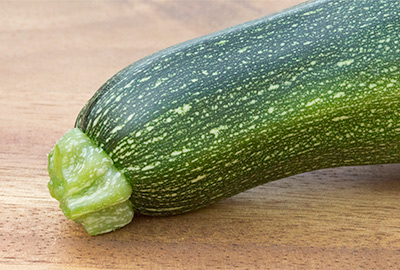
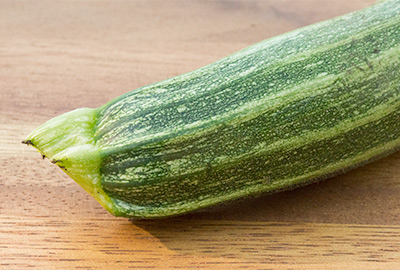
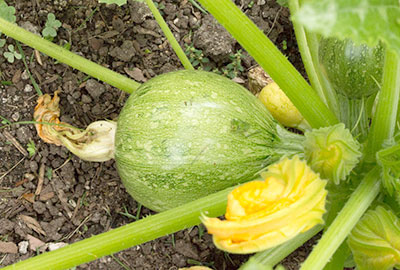
If you've had difficulty with diseases or low yields, try Burpee's Best, a vigorous and high-yielding hybrid; Emerald Delight, a flavorful, early hybrid that is also resistant to powdery mildew and mosaic virus; or Max's Gold, a vigorous and delicious yellow hybrid.
Sure Thing is a parthenocarpic hybrid that produces fruit reliably during cool weather and without pollination.
For novelty or fun, grow the French heirloom Baby Round or the hybrid Ball Mix, both of which produce round zucchini for stuffing or edible serving bowls; Gadzukes, which is star-shaped when sliced; or Limelight, a hybrid that produces flavorful, light-green fruits.
Buying/Selection Tips
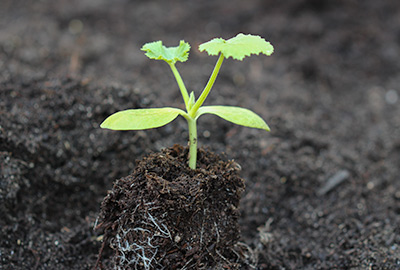
Purchase seeds, not seedlings. Zucchini should generally be seeded directly outdoors. GardenZeus recommends against purchasing zucchini starts for transplant, especially if rootbound or it has been more than about 2 weeks since germination, as starts may be prone to slow establishment, poor yield, diseases, pests, and other problems.
If you see small flowers on zucchini starts, do not purchase or plant them. They have already entered their reproductive cycle; this is a condition called "early senescence." If a zucchini start produces flower(s) while at a small size, it may never reach full size and may produce little or no yield.
For tips and information about purchasing vegetable seedlings, see : The GardenZeus Guide to Buying Vegetable Seedlings.
Soil Needs/Tip
Zucchini are heavy feeders that benefit from well-drained, loose, fertile soil with sufficient calcium and moderate-to-high organic matter. Avoid growing zucchini or any squash varieties in the same place for more than one season at a time to avoid depleting soil and concentrating pest populations and diseases.
See GardenZeus Alert: Beware of Heavy Feeders! for precautions about successive planting of vegetables that may deplete your soil.
As long as fertility and drainage are sufficient, zucchini performs well in a variety of soils. Zucchini is less fussy than some vegetables about soil acidity, and performs reasonably well in the range of about 5.8 to 6.9 pH.
Squash often grow slowly, produce little yield, become chlorotic, and may be prone to pests and diseases if planted in new, uncultivated, infertile, or compacted soils.
Suitable Microclimate
Zucchini needs full sun and sufficient space in fertile soil that is consistently moist but not wet. It does well in raised beds with southern and western exposures.
Ideal temperature range for germination is 70° to 95°F with fastest germination at the warmer end of this range. Ideal temperature range for growth and fruiting is about 65° to 75°F. Zucchini withstands temperatures up to 100°F, but growth and fruiting may be diminished at temperatures above 85°F, and flowers may drop at high temperatures. Most varieties grow slowly or not at all at temperatures below 60°F.
Zucchini benefits from shade during hot summer afternoons in warm-climate areas of California. See GardenZeus Tips for Shading Vegetables During Hot Weather for creative ideas from expert Darren Butler about providing shade.
Getting Started
Zucchini is a relatively easy vegetable that produces early and abundant yields, which make it a good choice for beginning gardeners. Seed zucchini directly outdoors beginning after frost risk is low and daytime temperatures are consistently 65° F and above.
Zucchini and other summer squash seed varieties sold in the United States generally are not sprawling, viney plants, and rarely form the 10-to-15-foot or longer vines that are common with winter squash. While zucchini plants may grow large, and some varieties grow densely to the point of making harvesting difficult, they stay within a smaller area than winter squash generally does, and so are often described as "bushy" or "compact."
In reasonably fertile soil and with appropriate care including frequent harvesting, a single zucchini plant can produce dozens of fruits over a period of months. A small number of mature plants, often 1 to 2 per couple or small family, are usually sufficient to produce plenty of zucchini for fresh eating and cooking, freezing for later, and giving away. For areas with long growing seasons, GardenZeus expert Darren Butler recommends starting 3 or 4 plants for every 2 to 3 family or household members, thin to the 1 or 2 strongest plants in each cohort, and repeat about every 2 to 3 months until 90 to 120 days before the end of the growing season.
Watering Tips
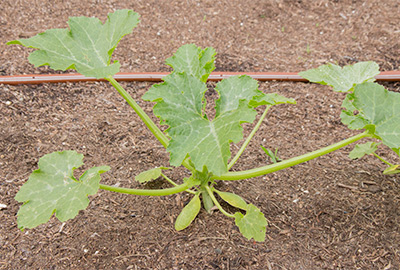
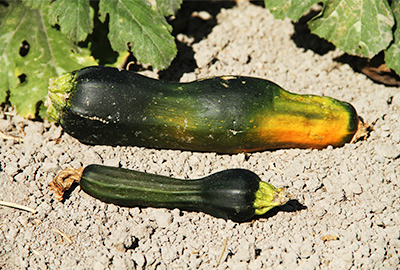
Zucchini plants benefit from consistent soil moisture and are prone to diseases in wet soils or if overwatered. Seeds may rot if kept overly wet when germinating. Avoid watering with sprinklers. Leaves of zucchini plants should be kept entirely dry as much as possible.
See The GardenZeus Guide to Watering Cucumbers, Melons, and Squash (Cucurbits) for tips and more information about watering zucchini.
Planting Method/Tips
Plant pre-germinated seeds (not transplants) or seed zucchini directly outdoors after frost risk is low and daytime temperatures are consistently 65°F and above.
Use raised beds filled with washed sand, local soil, and nutrient-rich compost or amendments rather than planting squash in new, uncultivated, or infertile soils. Squash does not perform well if planted into the compacted clay soils or infertile sandy soils that are common throughout California.
See Growing Summer Squash (Including Zucchini) in the California Home Garden for detailed information about growing zucchini.
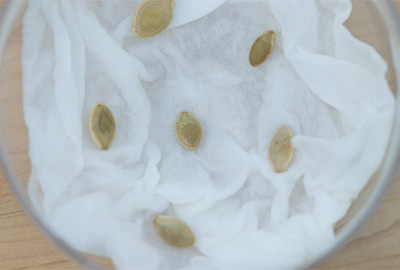
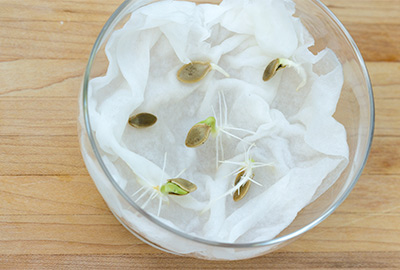
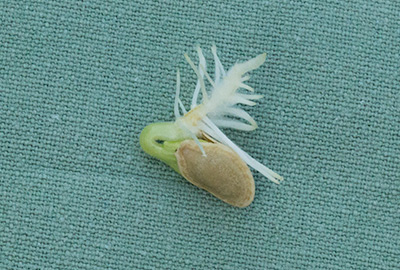
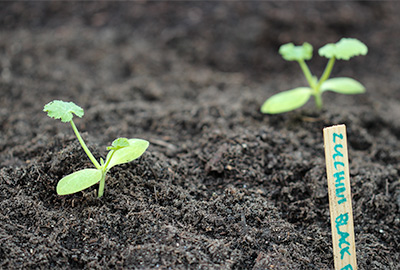
Spacing
Zucchini spacing depends upon variety, planting style, and available garden space. Summer squash is traditionally planted with 2 to 4 seeds per planting hole, then thinned to one plant per hole, spaced about 2.5 to 3.5 feet apart, or as little as 18 inches apart for small varieties and 4 feet or more for very large varieties. Plant seeds about 1 inch deep.
In gardens with ample space, zucchini can be planted in mounds that are raised several inches to a foot or more above grade, and often about 18 inches in diameter, with mounds spaced 3 to 4 feet apart from edge to edge. Plant a few to several seeds around the sides of the mound and thin to 1 or 2 plants per mound.
When grown in rows, plant zucchini seeds about 4 inches apart in rows 3 to 5 feet apart. Thin plants to one every 12 inches to 2.5 or 3 feet, depending upon variety.
Timelines
3 to 10 days or longer to seed germination. Generally, zucchini should germinate within a week if kept moist at temperatures of 70° to 95°F.
Transplanting is possible about 10 to 18 days after germination but recommended only for skilled biointensive gardeners and experienced gardeners who are willing to monitor seedlings closely.
10 to 21 days after germination to 1st thinning.
Thin to final spacing by about 3 to 4 weeks after germination, possibly longer during cool weather or for slow-growing plants.
About 3 to 5 weeks after germination to first harvest of squash blossoms.
45 to 80 days, rarely longer, from germination to first harvest of zucchini fruits, depending on variety and growing conditions.
Harvest Period: In fertile soil, with proper care and frequent harvest, depending on variety and growing conditions, an individual zucchini plant may remain productive for 2 to 7 months.
Pollination Needs/Tips
Summer squash are monoecious, meaning that a single plant produces both male and female flowers. Pollination is critical for zucchini to produce fruit.
It is normal for the first few blooms to fall off a squash plant. Early squash flowers are usually all male; no fruits will form from these flowers. If flowers continue falling off without forming fruit, or established plants drop female flowers and fail to form fruit, lack of pollination is usually the cause.
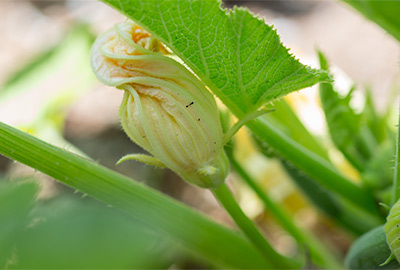
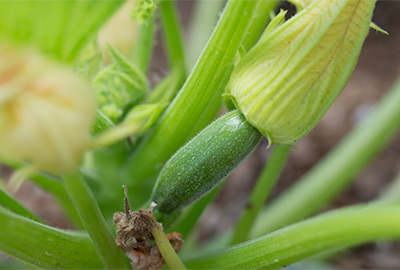
Male and female squash flowers are easily recognized with close observation. Male flowers tend to be on longer stems, and have only a stem at the base of the flower, while female flowers have a tiny immature fruit, which technically is the ovary, between the base of the flower and a shorter stem. Gardeners often assume the wrong gender for zucchini blooms. As GardenZeus expert Darren Butler has bravely clarified many times over the years, with zucchini blooms, unlike with humans, the flower with the tube is the girl.
Recognizing the gender of squash flowers is important because generally it's best to harvest the male flowers for cooking and eating, as they will never produce zucchini fruits; and also so that you will not become overly concerned if male flowers drop without forming fruits. Male squash flowers are often produced at a rate of 3 to 4 times the number of female flowers. Leave at least one male flower for every 2 to 4 female flowers to allow for pollination, and otherwise harvest and eat many to most of the male flowers.
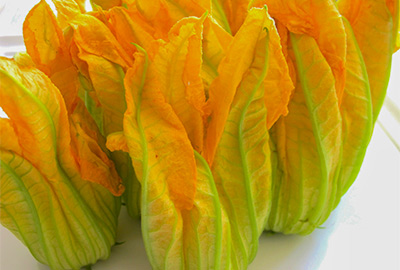
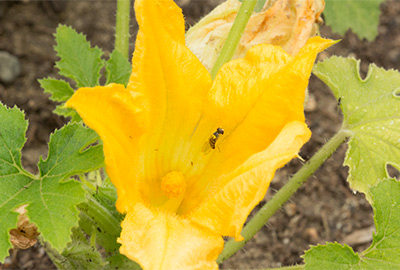
If female flowers or small fruit drop without maturing, you likely have a pollination problem; this is where the “bees” part of a zucchini birds-and-the-bees lesson comes in. Bees are primary pollinators for squash in home gardens; if you have a low or nonexistent bee population, you may have minimal yield with squash. Encourage bees by planting borage, nasturtium, rosemary, oregano, and other bee-attracting herbs and plants. It has been Darren Butler’s experience that squash blooms alone are not always a strong attraction for bees, but if they’re in the area collecting pollen and nectar from other flowers, bees will gladly pollinate squash.
If you've had low yields as a result of poor pollination, try the zucchini variety Sure Thing, a parthenocarpic hybrid that produces fruit without pollination. For most varieties, if unable to attract bees or other pollinators, you may need to pollinate squash by hand. Use a small paintbrush to transfer pollen, or pick male flowers and rub the stamens onto the pistils of female flowers.
Zucchini will cross readily with most varieties of summer squash (Cucurbita pepo). Long distances between different summer-squash varieties or isolation is required to save seeds that remain true-to-variety across multiple plant generations. In the home garden, this is often accomplished by tying off flowers and hand-pollinating. See "Advanced Tips" in the GardenZeus section "Special Care, Needs & Tips" for more information about saving zucchini seeds.
Interplanting/Companion Planting
Because lack of pollination is a primary reason for poor yield, GardenZeus recommends encouraging bees to visit your zucchini by planting it near borage, nasturtiums, rosemary, oregano, and other bee-attracting herbs and plants. Allowing vegetables like radishes and carrots to flower and persist in your garden through spring and summer may also attract bees and help with squash pollination.
Avoid planting root crops, such as beets, onions, and potatoes, near zucchini, which may disturb sensitive zucchini roots when harvested.
The Three Sisters is a traditional Native American agricultural grouping that includes corn, beans, and squash. Will this combination work in your garden? See GardenZeus Quick Tips: 'The Three Sisters' Companion Planting Combination for California
Nutrient/Amendment/Fertilization Needs/Tips
Zucchini are heavy feeders. A soil test is recommended to determine nutrient levels prior to applying fertilizer.
Work compost, composted manures, or well-rotted organic matter into soils before planting, and maintain nutrient-rich surface dressings under mulch. Bury plugs of finished compost or worm compost a few inches outside of the driplines of established zucchini plants 2 or 3 times per growing season and water thoroughly. For soils low in calcium, crush or grind up eggshells and add to the soil surface under mulch at the base of each plant. Grow squash or other cucurbits only once every 2 to 4 years in a given bed or garden area to allow the soil to recover between plantings.
GardenZeus recommends adding nitrogen in the form of diluted urea or a cup of chicken manure diluted in 4 gallons of water (half cup if fresh manure) and mixed thoroughly, after seedlings are a few to several inches tall and about once or twice per month thereafter. Adding too much nitrogen may result in rapid growth and lush, high-carbohydrate leaves that attract insect infestation; and slowed or reduced yields.
Reduce or discontinue fertilizing with nitrogen after late spring to avoid producing large, lush leaves that will tend to wilt and cause stress to the plant during summer heat.
Fish emulsion or seaweed extracts applied as drenches or foliar spray may be beneficial in soils that are infertile, alkaline, or lacking micronutrients.
Mulching
Mulching squash plants is particularly important, especially during warm-to-hot weather, to maintain even soil moisture, cool soils during hot weather, and inhibit weeds to avoid root disturbance to squash from weeding. Use a half-inch of fine mulch for small starts under 4 inches in height; increase to 1 to 2 inches or more of fine to medium mulch after plants are 6 to 12 inches tall.
Straw and/or pine needles make good mulches for squash. Having plenty of mulch around squash is a benefit when plants begin fruiting; mulch can be mounded here and there as necessary to support squash fruits and prevent them from resting on damp soil, which encourages prematurely rotted fruit.
Pruning/Cutting Back/Pinching/Separating
Squash plants may be pruned for size or to keep plants smaller when grown in containers. GardenZeus generally does not recommend cutting back or removing squash leaves or stems. One exception is judicious thinning of leaves if plants wilt persistently during hot weather despite having ample soil water.
For more information see The GardenZeus Guide to Watering Cucumbers, Melons, and Squash (Cucurbits)
Propagating
From seed. GardenZeus recommends open-pollinated, untreated, organically grown seeds.
Container Gardening
Because of its size and needs for above ground space and soil volume, zucchini is not an ideal container vegetable. It does well in raised beds or very large containers. Many varieties of zucchini need containers of about trash-can size filled with fertile, living soil to produce the same yields they would under similar conditions in the ground.
Most varieties of zucchini will produce good yields in well-drained containers that are at least 16 to 18 inches wide and deep, and some varieties, such as hybrids Raven, Astia, and Buckingham, yield well in much smaller containers of about 12 to 14 inches wide and deep. Since zucchini are so productive, it may be that smaller yields in containers are still plenty for your needs.
Plant 2 to 3 zucchini seeds per large container and thin to 1 to 2 plants when seedlings are 2 to 4 inches tall. Soil tends to dry out more frequently in containers or raised beds, so be sure to monitor as needed and provide sufficient and consistent water.
Seasonal Care
Zucchini is a warm-season crop because it is frost sensitive, but also tends to wilt and suffer in heat. It grows and fruits best at temperatures from 60° to 85°F, with optimal growing temperature between 65° and 75°F.
Seed zucchini or plant pre-germinated seeds directly outdoors when frost risk is low and daytime temperatures are consistently 65°F and above. Starting seedlings early, while temperatures are still cool to cold, increases risk of damage or loss of plants to frost, but also generally minimizes problems from insect pests, which can be so intense during warmer weather that it can be difficult to establish seedlings. Planting early also allows you to take advantage of zucchini's long productive period, which can last for months, before summer weather stresses plants and reduces yields.
Use row covers, or improvised materials such as cloth sheets or cardboard, overnight to protect plants from late frosts. Remove covers during the day for sunlight and to allow pollination by insects.
Many zucchini varieties fruit early; harvest may begin 45 to 60 days after germination. Keep zucchini harvested to encourage production of more fruits.
By late summer, after producing for weeks to months and suffering through summer weather, zucchini plants may not look their best. They may be infested by leafminers and other insects. Leaves may be covered in mildew, chlorotic, or bug-eaten. Plants often continue to produce yields for weeks despite looking ragged and unhealthy.
For growing from fall through spring in mild-winter California areas, be sure to plant zucchini where it will receive full sun throughout the winter, and grow cold-tolerant varieties, such as hybrids Sure Thing, Zucchini Elite, and Paycheck.
How to Harvest
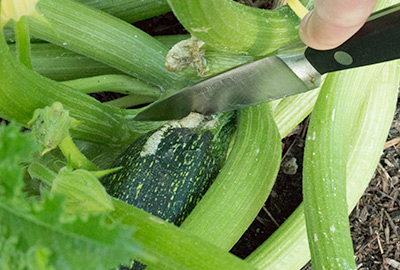
Use a sharp knife or garden scissors to harvest zucchini, making a cut on the stem about a half-inch to an inch above the fruit. Avoid the temptation to pull or twist the zucchini fruits as they are usually well-attached; overly aggressive attempts to remove fruits by hand may damage the fruits or plant.
Harvest when fruits are small and tender, and skin has not begun to toughen, generally at 5 to 7 inches in length.
Zucchini blossoms are often tender and least damaged by insects and environmental conditions just as they begin to open. GardenZeus recommends harvesting edible flowers in the morning or before temperatures heat up on a given day. Use a sharp knife or garden scissors to cut the zucchini bloom on its stem about a half-inch to an inch below the bloom. Remove the stem stub before cooking.
Harvesting Tips
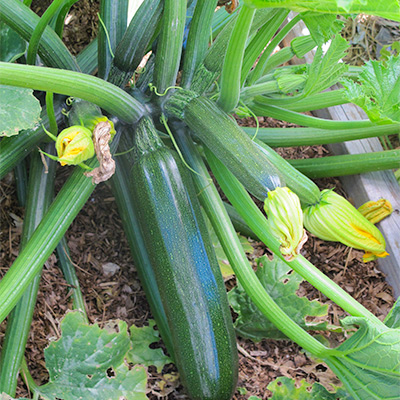
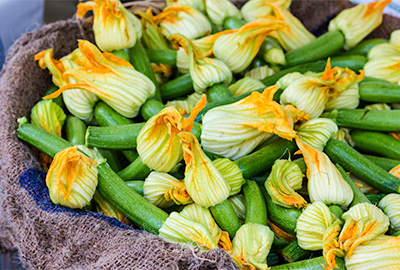
Zucchini fruits can grow at the rate of an inch per day; fruits may grow to several inches in length from one weekend to the next. For busy gardeners who don't check their plants regularly, this equates to sizable zucchini fruits simply appearing, like magic, from one time you're in the garden until the next. You may need to harvest multiple times per week or almost daily during productive periods to keep up with vigorous plants. Warm weather may cause zucchini fruits to grow and mature more rapidly.
If zucchini fruits grow too large, the skins toughen and the fruits develop seeds. Large zucchini fruits can still be eaten, but may be tougher and drier. Consider using larger fruits for baking rather than fresh eating.
Harvest often and while fruits are small to encourage new fruiting and abundant yields. A squash plant may stop producing new fruits while maturing existing fruits. Of greater concern is that after a zucchini plant has grown a few larger fruits, especially if the fruits are allowed to stay on the plant until they develop seeds, the plant may stop producing, decline, and die. If you allow the first few zucchini fruits to mature and develop seeds, that may be your entire harvest; whereas, if you harvest all fruits at 6-inch size, a zucchini plant may continue to produce for several months. Be sure to remove large zucchini fruits as soon as you notice them, even if you do not plan to eat them. GardenZeus recommends checking zucchini plants thoroughly every day or two while they are producing. Push leaves aside to look closely among stems, as missing even 1 or 2 fruits that grow to full size without your knowledge may reduce long-term yield from that plant.
What Commonly Goes Wrong
Overwatering and wet soils: Zucchini become stressed and susceptible to pests and diseases as a result of poor drainage or standing water. In poorly drained soils, it is possible for the soil surface to be dry but water to be perched or pooled beneath the surface.
Dropped blooms or fruit, lack of fruit production, sporadic fruit production on established plants, or small fruits that yellow or shrivel without growing to normal size: Male squash blossoms will never produce fruit. The first round of blooms on most summer squash is usually male, so an initial round of blossom drop is normal. If flowers continue falling off without forming fruit, or established plants drop female flowers and fail to form fruit, lack of pollination is usually the cause.
Bees are primary pollinators for squash in home gardens; if you have a low or nonexistent bee population, you may have minimal yield. Encourage bees by planting borage, nasturtium, rosemary, oregano, and other bee-attracting herbs and plants. It has been GardenZeus expert Darren Butler's experience that squash blooms alone are not always a strong attraction for bees, but if they're in the area collecting pollen and nectar from other flowers, they will gladly pollinate squash.
If you are unable to attract bees or other pollinators, you may need to pollinate squash by hand. Use a small paintbrush to transfer pollen, or pick male flowers and rub the stamens onto to the pistils of female flowers.
During hot weather, drought stress, or other environmental stresses, zucchini plants may produce only male flowers and therefore not produce fruit. Slow, poor, or uneven yields may also be caused by too much soil nitrogen.
Small yields or plants that put out one round of fruit and then decline or stop fruiting: This often results after one or more zucchini fruits are allowed to grow large or to maturity. If a few zucchini fruits grow large enough to set seeds, the parent plant will often stop producing new fruits and may decline and die. Be diligent in removing weeds and looking carefully among zucchini leaves and stems for fruits. Harvest all fruits when young, generally not more than 7 inches in length. The occasional zucchini gets past even the best of us; be sure to remove large zucchini fruits as soon as you notice them, even if you are not planning to eat them.
Bitter zucchini fruits: Zucchini may produce a biochemical that causes bitterness in response to environmental stresses, such as drought conditions or soil dryness between waterings, variable watering (too wet at times and too dry at others), hot temperatures or wide swings in temperature, and poor or infertile soils.
Chlorosis is iron deficiency that appears as lightening or yellowing between veins on older leaves and/or pale green or yellow new leaves. Affected leaves will never return to normal because iron is not a mobile nutrient, meaning that it cannot be relocated within a plant. Alkaline city water and alkaline soils are common causes of chlorosis; iron becomes decreasingly available to plants when soil pH is above 6.0, and is mostly unavailable at pH of 7.0 and above. Applying chelated iron will help temporarily but is not a long-term solution or cure, and chelated iron may rapidly become unavailable in alkaline soils. The best solutions are to encourage a thriving, healthy soil ecosystem that will naturally improve pH; provide acidity to soil by watering with diluted vinegar at proportions of about 1/4 to 1/2 cup of white vinegar in 2 gallons of water; or use an acidifying product such as pH Reducer.
Wilting: At high temperatures, zucchini is prone to wilting regardless of how much water is available in the soil; it is possible during hot periods for squash and other plants to transpire faster than their roots can uptake water. Any wilting is undesirable and stressful to plants, but can be difficult to prevent with squash during summer. GardenZeus recommends providing shade during hot afternoons with mobile trellises or other homemade methods, and if necessary, trimming portions of large leaves or thinning leaves if squash plants wilt in hot weather despite being well-watered.
Slow growth, lack of vigor, small plants, production of few or small roots or leaves, yellowing leaves, dried-out or brown leaves: These common symptoms may result from soil pH that is too high or too low, compacted soil, alkaline soil, overwatering, underwatering, irregular watering, poor drainage, warm or hot weather, lack of soil nitrogen, other soil nutrient deficiencies, or a combination of these. They may also be the result of hot weather, wind, or other environmental and abiotic factors. Burned leaf tips may also result from overfertilizing, sodic soils, or soluble salts in soils.
Not a Problem
Zucchini plants often drop the first round of blooms without producing any fruits. These blooms are usually male, which are incapable of fruiting. If blossom-dropping persists, lack of pollination is likely the cause.
As zucchini fruits grow large, their rinds or skins toughen and become less palatable. This is normal; at large fruit size, the inside flesh of zucchini remains edible, although possibly less flavorful or more bitter, up to the point that seeds form inside overmature fruits.
Common Diseases
Mildews: Powdery and downy mildew are the most common leaf-diseases of squash in many portions of California. They appear as a whitish circles or whitish layers on the upper or lower surfaces of leaves, yellowing or dead spots, or pale or yellow angular leaf sections, and may be mistaken for other problems, such as nutrient deficiencies. Powdery mildew is more commonly a problem in many parts of California than downy mildew, and especially prevalent later in summer or after periods of hot weather. Avoid wetting foliage when watering. Some mildews can be discouraged using a nontoxic homemade spray of one tablespoon each of baking soda and tea tree oil per quart of water, shaken vigorously and regularly as applied via spray bottle. Mildews are often difficult to control and are best managed through prevention and good cultural practices, such as planting resistant varieties, planting in areas with good air circulation, keeping foliage dry, less-frequent irrigation, encouraging biologically active "living" soil that will support strong plant immune systems, and rotating crops. Mildews are often not fatal and squash may produce reasonable yields and fresh uninfected leaves despite ongoing infections on older leaves. The majority of squash plants develop mildew infections by mid-to-late summer in warm weather portions of California, as their vigorous fruiting slowly exhausts them and their immune systems weaken.
Squash are susceptible to soil pathogens, particularly in wet and waterlogged soils, including Phytophthora, Fusarium, and Verticilium. These pathogens may persist in soils for many years. Plant resistant varieties, avoid planting in soils where the pathogens are known to have infested plants during the past several years, avoid overwatering, provide appropriate cultural conditions, and encourage a living soil ecosystem that will naturally support plants and inhibit soil pathogens.
Bacterial wilt is purportedly on the rise as a squash disease in home gardens, but GardenZeus expert Darren Butler has not yet seen this commonly in gardens in California. It is spread by cucumber beetles, and results in wilting of entire plants despite sufficient soil moisture. Plants cannot be cured, and should be removed as soon as possible to reduce the likelihood of the wilt spreading to other plants.
Mosaic viruses are more commonly an issue in large-scale agriculture or on commercial farms but may show up occasionally in the home garden and be a serious disease in squash. Initial symptoms include yellowing, spotting, mottling, or distortion in leaves and fruit. Fruits may be bitter or inedible, and viruses may seriously weaken plants. Multiple virus strains are spread by different insects, and often more than one virus is involved in a given infestation. In the home garden, it is generally not worth the time and expense to complete lab testing. Controlling known insect vectors, such as aphids and whiteflies, may slow the spread of the virus(es). Plant resistant varieties, provide appropriate cultural conditions, and encourage a living soil ecosystem that will naturally support plants. There is no effective known cure once plants are infested.
Common Pests
Common pests of zucchini include leafminers, aphids, whiteflies, spider mites, cabbage loopers, squash bugs, cucumber beetles, and armyworms. Potato bugs or sow bugs and earwigs often devastate seedlings, especially in newly cultivated and overly wet soils, If your seeds apparently fail to germinate, or if small seedlings disappear overnight or are chewed back to stems, check for moist areas nearby that may be harboring these insects (or technically crustaceans, in the case of potato bugs). Birds also may eat seedlings, blooms, and new leaves.
Special Care
Keep zucchini beds well-weeded. Weeds compete with squash plants for space, water, and nutrients, but more importantly, you may have difficulty finding zucchini fruits when plants are choked with weeds, and allowing even a few zucchini fruits to grow to maturity unharvested may drastically reduce your long-term yield.
Special Info
Zucchini fruits are about 95% water, and have a higher water content than watermelon, which is about 92% water. GardenZeus expert Darren Butler has long believed that we hydrate better by eating fresh fruits and vegetables or healthy fresh juices than by drinking water; consider eating a fresh, raw zucchini or other high-water-content fruits and vegetables after cooling down from a workout, before taking a hike, or anytime good hydration is needed.
Italian singular and plural words for squash ("zucca," "zucchini, and "zucchine") provided the origins for the English name "zucchini." Native Americans called squash "the apple of God."
While zucchini are generally considered vegetables, they are actually fruits in the botanical sense that the fruit of any plant is the part that contains seeds. For purposes of provided gardening information, GardenZeus may refer to squash and other vegetables that contain seeds as "fruits."
Sustainable Landscaping Tip
Because it is so abundantly productive over a long period, zucchini can be an important crop for local and seasonal food security, and may be a suitable crop for producing high yields under difficult conditions. It requires ample moisture to yield well but is damaged or killed by frost, so it is not a good match for germinating during natural winter rainfall or naturalizing in most areas of California.
Good and right relations with friends and neighbors are an important part of a sustainable lifestyle, and zucchini can support good neighborhood relations because it produces so many fruits that inevitably some must be given away. This provides an excuse to renew acquaintanceships and knock on the doors of people in your neighborhood whom you haven't met.
Advanced Tip
It is possible to grow zucchini during winter outdoors in cold frames or with frost protection in many portions of California. Be sure to plant in an area that receives full sun throughout the winter, and grow cold-tolerant varieties, such as hybrids Zucchini Elite and Black Jack. Plant winter zucchini in pots to be brought into heated garages on cold nights, or plant in the ground in cold frames or with daily monitoring of weather, and provide frost-protection as needed. In mild years and areas, simple overnight protection using large cardboard boxes may be sufficient. On cold days or during long cold snaps, protect zucchini from frost with cages or wire frameworks covered in opaque plastic or cloth such that the cloth does not touch leaves or small stems. Watering before a cold period will help retain heat in the soil, and fully hydrated squash plants are less susceptible to frost.
Saving zucchini seeds generally requires tying off female flowers before they open with a stocking, paper bag, or other "hood;" removing coverings once blooms are open to pollinate by hand; then tying off the pollinated blooms again to avoid further pollination by insects. If saving seeds, allow fruits to remain on the vine until they grow to full size, harden, lose their coloring, and dry. When the stem attached to a given zucchini fruit is brown and dead, this is usually a good indication that seeds are ready to harvest.
Preservation, Storage, and Use
Zucchini is a traditional ingredient in many dishes originating in the Mediterranean. It is eaten raw as sliced or shredded in fresh salads. It can be steamed, sauteed, fried, grilled or chopped for use in soups and stews. Shredded, it adds great flavor to muffins and breads. Zucchini makes a superb gratin, and is a traditional ingredient in ratatouille, along with eggplant, onions, peppers, and tomatoes. Try calabacitas, a traditional New Mexican dish with onion, garlic, corn, chilies, and again, zucchini.
GardenZeus recommends retaining and eating zucchini skins whenever possible as the majority of nutrients are in the skins. Zucchini blossoms are very delicate and should be eaten the day they are harvested. Blossoms are wonderful stuffed with ricotta; or stuffed with mozzarella, dipped in batter, and deep fried.
Because of their soft rinds and high water content, zucchini do not store well for long periods. They are best eaten immediately after harvest, or within a few days at the most. Under ideal storage conditions of 41° to 50° F, which is warmer than the typical home refrigerator temperature, zucchini may last up to 10 days without yellowing, decaying, or pitting, but a more reasonable storage time is a few to several days. Zucchini stored at temperatures below 41° F may degrade.
Zucchini is sensitive to ethylene, so when storing zucchini, take care to place it away from ethylene-producing fruits, including apples, avocados, melons, and stone fruits. Damaged, bruised, or rotting fruits may produce increased amounts of ethylene.
For longer-term storage of zucchini, GardenZeus recommends freezing. Sliced zucchini stored in airtight containers or freezer bags will keep for 2 to 3 months. To extend storage life, blanch zucchini slices for 2 minutes in boiling water, then immerse in ice water to cool. When blanched before freezing, zucchini slices will keep for a few to several months. Eating quality of frozen zucchini degrades over time; flavor may be lost and/or slices may become soggy.
Other options for storing zucchini include grating or shredding, and freezing in airtight containers or bags for use in baking; or cooking, pureeing, and freezing for use in soups.
In recent years, the FDA has recommended that zucchini NOT be canned due to high risk of bacterial contamination.
Like other cucurbits, most of the nutritional value of zucchini is contained in its skin, which is high in antioxidants; vitamins, including vitamin A (beta-carotene), B complex, and C; minerals, including manganese, magnesium, calcium, folate, potassium, copper, phosphorus, zinc, and niacin; and dietary fiber. Zucchini has many proven and presumed health benefits, and may support or promote reduction in blood pressure, lower cholesterol levels, healthy vision, strong skin and hair, and effective management of weight and diabetes.